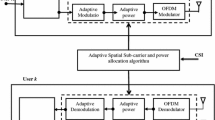Abstract
This paper presents adaptive per-spatial stream power allocation algorithms for Single User Multiple-Input Multiple-Output Orthogonal Frequency Division Multiplexing (SU MIMO-OFDM) systems. Three efficient and low-complexity Greedy Power Allocation (GPA) algorithms are proposed to maximize the throughput and spectral efficiency of the SU MIMO-OFDM systems. Firstly, the low-complexity pre-coded GPA algorithms are developed for the MIMO systems. The spatial sub-channels are created by applying the so-called Singular Value Decomposition (SVD) technique on the MIMO channel matrix, and then the Pre-GPA algorithms are applied to exploit the multi-path and spatial diversities. Secondly, the spatial and frequency diversities are exploited by adaptively allocating the system sub-carriers to the spatial sub-channels followed by Per-Spatial GPA (PSGPA). Finally, spatial multiplexing-based GPA algorithms are proposed to optimize the spectral efficiency of the SU MIMO-OFDM system. An optimal two-dimensional Spatial-Frequency GPA (SFGPA) algorithm is proposed to efficiently improve the average system spectral efficiency. The high computational complexity of the optimal SFGPA solution is simplified by proposing a low-complexity Per-Spatial GPA with Excess Power Moving down (PSGPA-EPMd) algorithm, which moves the per-spatial excess power downwards to enhance the spectral efficiency of the spatial multiplexing-based SU MIMO-OFDM systems. The proposed algorithms achieve better spectral efficiency and maximize the throughput in comparison with conventional algorithms.
















Similar content being viewed by others
References
Alamouti, S. M. (1998). A simple transmit diversity technique for wireless communications. IEEE Journal on Selected Areas in Communications, 16, 1451–1458.
Foschini, G. J., & Gans, M. J. (1998). On limits of wireless communications in a fading environment when using multiple antennas. Wireless Personal Communications, 6, 311–335.
Telatar, E. (1999). Capacity of multi-antenna Gaussian channels. European transactions on Telecommunications, 10, 585–595.
Andrews, J. G., Ghosh, A., & Muhamed, R. (2007). Fundamentals of WiMAX: Understanding broadband wireless networking. Upper Saddle River: Prentice Hall PTR.
Stauffer, E., & Hochwald, B. (2012). Low-complexity multi-stream space-time codes—Part I: Direct-sum codes and design criteria communications. IEEE Transactions on Communications, 60(1), 81–88.
Hochwald, B. M., & Marzetta, T. L. (2000). Unitary space-time modulation for multiple-antenna communications in Rayleigh flat fading. IEEE Transactions on Information Theory, 46, 543–564.
Paulraj, A. J., Gore, D. A., Nabar, R. U., & Bolcskei, H. (2004). An overview of MIMO communications-a key to gigabit wireless. Proceedings of the IEEE, 92, 198–218.
Choi, W., & Andrews, J. G. (2007). Downlink performance and capacity of distributed antenna systems in a multi-cell environment Wireless Communications. IEEE Transactions on Wireless Communications, 6(1), 69–73.
Foschini, G. J. (1996). Layered space time architecture for wireless communication in a fading environment when using multi-element antennas. Bell Labs Technical Journal, 1, 41–59.
Xianming, L., Xiaolin, W., Xinwei, G., Debin, Z., & Wen, G. (2012). Low bit-rate video coding via mode-dependent adaptive regression for wireless visual communications. In Proceedings of visual communications and image processing (VCIP) IEEE conference.
Bolcskei, H., Gesbert, D., & Paulraj, A. J. (2002). On the capacity of OFDM-based spatial multiplexing systems. IEEE Transactions on Communications, 50, 225–234.
Linglong, D., Zhaocheng, W., & Zhixing, Y. (2012). Time-frequency training OFDM with high spectral efficiency and reliable performance in high speed environments. IEEE Journal on Selected Areas in Communications, 30(4), 295–707.
Hu, S., Guan, Y. L., Bi, G., & Li, S. (2012). Cluster-based transform domain communication systems for high spectrum efficiency. IET Communications, 6(16), 2734–2739.
Bolcskei, H., & Paulraj, A. J. (2000). Space-frequency coded broadband OFDM systems. In Wireless communications and networking conference-2000 (WCNC-2000) IEEE, pp. 1–6.
Wyglinski, A. M., Labeau, F., & Kabal, P. (2005). Bit loading with BER-constraint for multicarrier systems. IEEE Transactions on Wireless Communications, 4, 1383–1387.
Papandreou, N., & Antonakopoulos, T. (2008). Bit and power allocation in constrained multicarrier systems: The single-user case. EURASIP Journal on Advances in Signal Processing, 2008, 11.
Zeng, L., McGrath, S., & Cano, E. (2009). Rate maximization for multiband OFDM ultra wideband systems using adaptive power and bit loading algorithm. In Fifth advanced international conference on Telecommunications-2009 (AICT’09), pp. 369–374.
Alhanafy, W., & Weiss, S. (2009). A new low-cost discrete bit loading using greedy power allocation. In The third mosharaka international conference on communications, computers and applications (MIC-CCA2009), 26–28 October, 2009.
Shin, C., Park, H., Kang, J., & Nam, E. (2010). A per-stream coded bit loading algorithm for MIMO BIC-OFDM systems. In 2010 international ITG workshop on smart antennas (WSA), pp. 240–243.
Goldsmith, A. (2005). Wireless communications. Cambridge: Cambridge University Press.
Odhah, N. A., Dessouky, M. I., Al-Hanafy, W. E., & Abd El-Samie, F. E. (2012). Low complexity precoded greedy power allocation algorithms for OFDM communication systems. Journal of Signal and Information Processing, 3, 185–191.
Odhah, N. A., Dessouky, M. I., Al-Hanafy, W. E., & Abd El-Samie, F. E. (2012). Greedy Power Allocation Algorithm for proportional resource allocation in multi-User OFDM systems. In 29th national radio science conference (NRSC’29), Cairo University, Egypt.
Odhah, N. A., Dessouky, M. I., Al-Hanafy, W. E., & Abd El-Samie, F. E. (2012). Per-spatial stream power allocation algorithms for single-user MIMO-OFDM wireless communication systems. In The 8th international conference on informatics and systems, INFOS’12, Cairo, Egypt.
Author information
Authors and Affiliations
Corresponding author
Rights and permissions
About this article
Cite this article
Odhah, N.A., Hassan, E.S., Dessouky, M.I. et al. Adaptive Per-spatial Stream Power Allocation Algorithms for Single-User MIMO-OFDM Systems. Wireless Pers Commun 98, 1–31 (2018). https://doi.org/10.1007/s11277-017-4186-3
Published:
Issue Date:
DOI: https://doi.org/10.1007/s11277-017-4186-3




